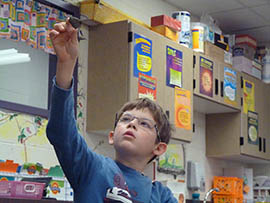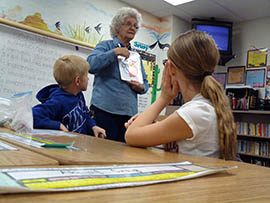- Slug: BC-CNS-Rock On,850
- Sidebar: Mining and Mineral Museum.
- Photos available (thumbnail, caption below)
By HARMONY HUSKINSON
Cronkite News Service
QUEEN CREEK – In a classroom of 23 third- and fourth-graders at Desert Mountain Elementary School, piles of gems and minerals are spread across miniature desks.
Mardy Zimmermann, a retiree volunteering with the Earth Science Museum, holds up an arrowhead carved from a dark stone.
“OK scientists,” she says. “Where does obsidian come from?”
“Lava!” exclaims an excited boy in a red sweatshirt.
“That’s right,” Zimmermann tells him with a smile.
These students are learning about the geologic processes behind and the industrial uses of 22 different rocks and minerals.
The nonprofit Earth Science Museum provides free, interactive lessons about geology to schools in the Phoenix area with the goal of replacing what organizers describe as a gap in education programming after the 2011 closure of the Arizona Mining and Mineral Museum.
In addition to its education outreach, the organization aims to eventually open a new, privately funded earth science museum.
In 2010 – the Mining and Mineral Museum’s last full year of existence – more than 25,100 students visited its former location near the State Capitol, according to an annual report from the Department of Mines and Mineral Resources.
Students bused into the museum had a chance to see the treasures of Arizona’s mineral collection, including a 7-foot-tall hunk of copper and a moon rock.
Zimmermann, a retired educator, used to volunteer and coordinate education programming for the old Mining and Mineral Museum, which she said closed so abruptly in 2011 that schools planning to visit the next week had to cancel their field trips.
“The schools and the kids were clearly the victims of this misguided effort. And rather than worrying about who did it and who what, when you have a disaster, the first thing you do is help the victims,” she said.
In February 2010, Gov. Jan Brewer introduced plans to open a centennial-themed museum in the old museum’s space. The Legislature voted to close the Mining and Mineral Museum and transfer responsibility for the state’s mineral collection to the Arizona Historical Society.
Funding for the new museum stalled during the recession.
Madison Barkley, curator of the Arizona Historical Society’s earth science collection, said plans for the Arizona Experience Museum haven’t yet been dropped, but in the meantime the historical society will soon open a natural history exhibit at the Museum at Papago Park in Tempe.
Rather than despair at the closure of the old mineral museum, Zimmermann said she and other volunteers tried to move forward with the Earth Science Museum and provide an educational service to students.
“It was very unfortunate, but to take away a historic science museum abruptly and have nothing in its place but an empty building, that was just unconscionable,” she said. “And so my first attitude was, ‘We have to go to schools.’”
As the vice president of education and the outreach coordinator for the Earth Science Museum, Zimmermann designed the nonprofit’s educational programming to have larger minerals and be more interactive.
The Earth Science Museum has a small group of volunteers and builds its education kits from rocks, minerals and fossils donated by local geology clubs. Last year, volunteers visited 24 schools, connecting with 2,283 students.
After a presentation, the schoolteacher can keep kits about minerals and rocks to continue the lessons, Zimmermann said.
Harvey Jong, president of the Earth Science Museum, volunteered at the old museum for 10 years until it closed. He said bringing rocks and minerals into classrooms allows for a special educational experience.
“By looking at a picture on the Internet of a piece of sandstone, you can’t know how it feels,” Jong said.
Carla Quintero, the students’ teacher, said the lesson brought her classroom an experience she couldn’t have provided herself.
“Definitely a more knowledgeable person is here to explain and be more thorough and tie it to what we use in everyday life, what rocks and minerals are in things that we use in everyday life,” she said.
Barkley from the Arizona Historical Society said that the society doesn’t have enough staff to visit schools for geology lessons, but it does offer geology kits that cost $10 to $35.
This year, the Earth Science Museum hopes to expand its outreach beyond the greater Phoenix area into rural communities like Pinetop-Lakeside via local geology clubs.
“Part of a project like this is we don’t have to just teach, we have to inspire. And that’s what the Mining and Mineral Museum did for a lot of kids. It was so awesome, it inspired them. But this project does too,” Zimmermann said.
^___=
Past
• 2011: Arizona Mining and Mineral Museum closes to make way for a new Arizona Centennial Museum. Ownership of the state’s mineral collection is transferred from the Department of Mines and Minerals to the Arizona Historical Society.
• 2012: The proposed museum’s name changes to the Arizona Experience Museum after the project isn’t finished in time for the Arizona Centennial.
Present
• January 2014: For the fourth straight year, Sen. Edward Ableser, D-Tempe, introduces legislation to reopen the Arizona Mining and Mineral Museum.
• The Arizona Experience Museum remains in the planning phases.
• Several of the specimens from the state’s mineral collection are on display at the University of Arizona Mineral Museum, including a 225-pound azurite boulder from Bisbee.
Future
The Arizona Historical Society plans to open a natural history exhibit featuring several of the state’s rocks and minerals in April at the Museum at Papago Park in Tempe.
^___=

Connor Pearce, a third-grader at Desert Mountain Elementary School in Queen Creek, holds a piece of chalcopyrite, commonly referred to as fool’s gold, up to the light to see if it sparkles during a free presentation by the by the Earth Science Museum. (Cronkite News Service Photo by Harmony Huskinson)

Mardy Zimmermann, a retiree volunteering with the Earth Science Museum, teaches students at Desert Mountain Elementary School in Queen Creek, about Arizona’s rocks and minerals. (Cronkite News Service Photo by Harmony Huskinson)